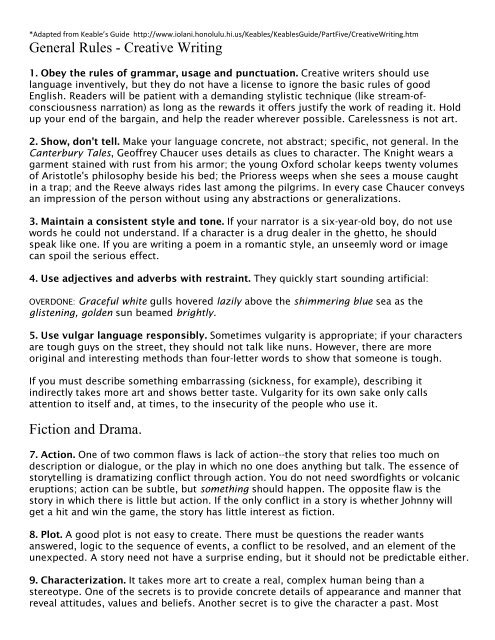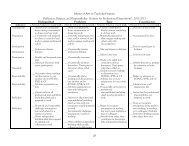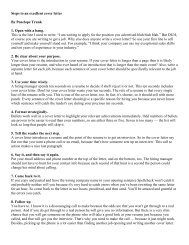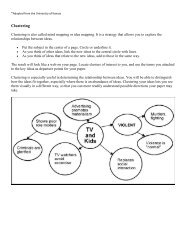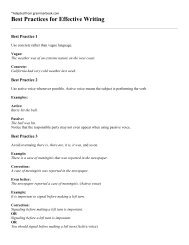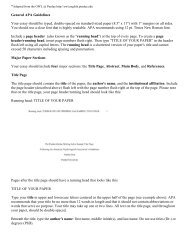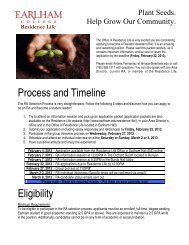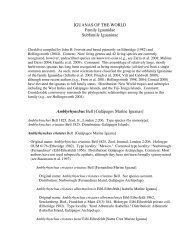Create successful ePaper yourself
Turn your PDF publications into a flip-book with our unique Google optimized e-Paper software.
*Adapted from Keable’s <strong>Guide</strong> http://www.iolani.honolulu.hi.us/Keables/Keables<strong>Guide</strong>/PartFive/<strong>Creative</strong><strong>Writing</strong>.htm<br />
General Rules - <strong>Creative</strong> <strong>Writing</strong><br />
1. Obey the rules of grammar, usage and punctuation. <strong>Creative</strong> writers should use<br />
language inventively, but they do not have a license <strong>to</strong> ignore the basic rules of good<br />
English. Readers will be patient with a demanding stylistic technique (like stream-ofconsciousness<br />
narration) as long as the rewards it offers justify the work of reading it. Hold<br />
up your end of the bargain, and help the reader wherever possible. Carelessness is not art.<br />
2. Show, don't tell. Make your language concrete, not abstract; specific, not general. In the<br />
Canterbury Tales, Geoffrey Chaucer uses details as clues <strong>to</strong> character. The Knight wears a<br />
garment stained with rust from his armor; the young Oxford scholar keeps twenty volumes<br />
of Aris<strong>to</strong>tle's philosophy beside his bed; the Prioress weeps when she sees a mouse caught<br />
in a trap; and the Reeve always rides last among the pilgrims. In every case Chaucer conveys<br />
an impression of the person without using any abstractions or generalizations.<br />
3. Maintain a consistent style and <strong>to</strong>ne. If your narra<strong>to</strong>r is a six-year-old boy, do not use<br />
words he could not understand. If a character is a drug dealer in the ghet<strong>to</strong>, he should<br />
speak like one. If you are writing a poem in a romantic style, an unseemly word or image<br />
can spoil the serious effect.<br />
4. Use adjectives and adverbs with restraint. They quickly start sounding artificial:<br />
OVERDONE: Graceful white gulls hovered lazily above the shimmering blue sea as the<br />
glistening, golden sun beamed brightly.<br />
5. Use vulgar language responsibly. Sometimes vulgarity is appropriate; if your characters<br />
are <strong>to</strong>ugh guys on the street, they should not talk like nuns. However, there are more<br />
original and interesting methods than four-letter words <strong>to</strong> show that someone is <strong>to</strong>ugh.<br />
If you must describe something embarrassing (sickness, for example), describing it<br />
indirectly takes more art and shows better taste. Vulgarity for its own sake only calls<br />
attention <strong>to</strong> itself and, at times, <strong>to</strong> the insecurity of the people who use it.<br />
Fiction and Drama.<br />
7. Action. One of two common flaws is lack of action--the s<strong>to</strong>ry that relies <strong>to</strong>o much on<br />
description or dialogue, or the play in which no one does anything but talk. The essence of<br />
s<strong>to</strong>rytelling is dramatizing conflict through action. You do not need swordfights or volcanic<br />
eruptions; action can be subtle, but something should happen. The opposite flaw is the<br />
s<strong>to</strong>ry in which there is little but action. If the only conflict in a s<strong>to</strong>ry is whether Johnny will<br />
get a hit and win the game, the s<strong>to</strong>ry has little interest as fiction.<br />
8. Plot. A good plot is not easy <strong>to</strong> create. There must be questions the reader wants<br />
answered, logic <strong>to</strong> the sequence of events, a conflict <strong>to</strong> be resolved, and an element of the<br />
unexpected. A s<strong>to</strong>ry need not have a surprise ending, but it should not be predictable either.<br />
9. Characterization. It takes more art <strong>to</strong> create a real, complex human being than a<br />
stereotype. One of the secrets is <strong>to</strong> provide concrete details of appearance and manner that<br />
reveal attitudes, values and beliefs. Another secret is <strong>to</strong> give the character a past. Most
*Adapted from Keable’s <strong>Guide</strong> http://www.iolani.honolulu.hi.us/Keables/Keables<strong>Guide</strong>/PartFive/<strong>Creative</strong><strong>Writing</strong>.htm<br />
short s<strong>to</strong>ries narrate only one or two incidents, but good s<strong>to</strong>ries often give us a sense of the<br />
characters' entire lives. Why are they the way they are? Have they been affected by the place<br />
where they live, the parents who raised them, their work, their marriage? The writer faces<br />
the challenge not only of making characters four-dimensional, but of unfolding the<br />
dimensions gradually and naturally.<br />
10. Introducing dialogue. Common errors:<br />
a. Introduce dialogue grammatically. A verb like said is required. Some verbs require an<br />
indirect object:<br />
WRONG: He <strong>to</strong>ld, "I'm leaving."<br />
RIGHT: He <strong>to</strong>ld his girlfriend, "I'm leaving."<br />
Not all verbs that describe manner or speech can introduce dialogue by themselves:<br />
WRONG: "Your move," he smiled.<br />
RIGHT: "Your move," he said with a smile.<br />
WRONG: He shrugged, "If you say so."<br />
RIGHT: Shrugging, he said, "If you say so."<br />
b. Identify the speakers with a phrase like "he said." You may know who is speaking in<br />
each paragraph, but your reader needs help.<br />
c. Vary the location of the "he said" phrases. It is mono<strong>to</strong>nous if the "he said" phrase<br />
comes at the beginning or end of every paragraph. Do not keep the reader wondering who<br />
is speaking:<br />
WRONG: "I hate <strong>to</strong> disappoint you, but I think you're making a big mistake. Are you sure you'll<br />
feel this way next week? Or next year? Do you think you can just walk back in<strong>to</strong> your<br />
girlfriend's arms if you should someday change your mind?" my sister asked.<br />
BETTER: "I hate <strong>to</strong> disappoint you," my sister counseled, "but I think. . . ."<br />
d. Vary the verbs that introduce dialogue. Avoiding repetition of say ("he said," "she said")<br />
is a problem all writers of fiction face. Any technique can sound mono<strong>to</strong>nous and artificial if<br />
you overuse it, including adverbs ("he said tenderly") and inversion ("said the butler"). Edgar<br />
Allan Poe used inversion in the famous refrain of "The Raven" ("Quoth the raven,<br />
'Nevermore'") because he wanted the poem <strong>to</strong> sound archaic and artificial.<br />
A list of alternatives is provided below. Many words on the list would be appropriate only in<br />
certain contexts. The dullness of "he said" is preferable <strong>to</strong> something outlandish or artificial<br />
("he opined"; "she queried"). Use the thesaurus, the dictionary, and your own imagination. A<br />
metaphor (twitter, erupt) can be effective if the context is right. Always remember that<br />
writing "he nagged" or "she whined" is less effective than showing your character nagging or<br />
whining.
*Adapted from Keable’s <strong>Guide</strong> http://www.iolani.honolulu.hi.us/Keables/Keables<strong>Guide</strong>/PartFive/<strong>Creative</strong><strong>Writing</strong>.htm<br />
admit concede hint observe snarl<br />
affirm confess hiss plead snicker<br />
avow conjecture huff protest snort<br />
bawl coo inquire purr spout<br />
beg declare insist rage squawk<br />
bellow demand interject rail squeal<br />
boast explain jeer rave tease<br />
cackle greet lament recall vow<br />
cajole groan lie remark warble<br />
carp growl mimic roar whimper<br />
chant grumble mutter scold whine<br />
chide grunt needle shriek whisper<br />
claim gush note sigh yelp<br />
11. Verb tense. Most s<strong>to</strong>ries and novels are in the past tense for good reason. It sounds<br />
natural. When you tell a child the s<strong>to</strong>ry of the <strong>to</strong>r<strong>to</strong>ise and the hare, or simply report <strong>to</strong> a<br />
friend what happened over the weekend, you use past tense. Present tense narrative is not<br />
original or innovative; it has been tried often. Sometimes it only calls attention <strong>to</strong> itself and<br />
sounds awkward:<br />
The burglar pulls the trigger. I duck, but I am <strong>to</strong>o late. I am rushed <strong>to</strong> the hospital, where I<br />
lie in a coma for two months. My family fears for my life. Every night my mother sits at my<br />
bedside crying. I recover, but over the next year my personality changes gradually. I become<br />
a serial killer. I am sentenced <strong>to</strong> death. I die. My mother weeps at my funeral.<br />
You may use present tense, but (as with any stylistic technique) you should have a good<br />
reason.


